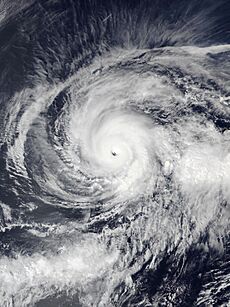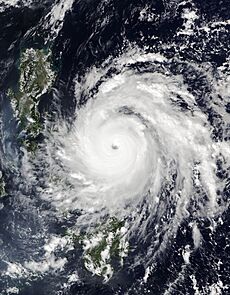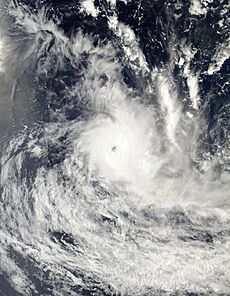Tropical cyclone naming facts for kids
Tropical cyclones and subtropical cyclones are powerful storms that form over warm ocean waters. To make it easier for everyone to understand and track these storms, weather experts give them names. This helps avoid confusion, especially when several storms are active at the same time in the same ocean area.
Storms usually get a name once their winds reach a certain speed, often around 33 knots (about 61 km/h or 38 mph). Before personal names became common, storms were sometimes named after places, objects, or even saints' feast days. A meteorologist named Clement Wragge from Australia is often given credit for being one of the first to use personal names for storms between 1887 and 1907. After World War II, using names for storms became a standard practice in many parts of the world.
Contents
- How Storms Get Their Names
- North Atlantic Ocean Storms
- Eastern and Central Pacific Ocean Storms
- Western Pacific Ocean Storms (180° – 100°E)
- North Indian Ocean Storms (100°E – 45°E)
- South-West Indian Ocean Storms (west of 90°E)
- Australian Region Storms (90°E – 160°E)
- Southern Pacific Ocean Storms (160°E – 120°W)
- South Atlantic Ocean Storms
- See also
How Storms Get Their Names
| Tropical cyclone naming institutions | ||||
|---|---|---|---|---|
| Ocean Area | Who Names Them | Area of Responsibility | ||
| Latitudes | Longitudes | |||
| Northern Hemisphere | ||||
| North Atlantic | United States National Hurricane Center | Equator northward | 140°W – European and African Atlantic Coasts | |
| Eastern Pacific | ||||
| Central Pacific | United States Central Pacific Hurricane Center | Equator northward | 180° – 140°W | |
| Western Pacific | Japan Meteorological Agency | Equator – 60°N | 100°E – 180° | |
| PAGASA (unofficial) | 5°N – 21°N | 115°E – 135°E | ||
| North Indian Ocean | India Meteorological Department | Equator northward | 40°E – 100°E | |
| Southern Hemisphere | ||||
| South-West Indian Ocean |
Mauritius Meteorological Services | Equator – 40°S | 55°E – 90°E | |
| Météo Madagascar | Equator – 40°S | African Coast – 55°E | ||
| Météo-France Reunion | Equator – 40°S | African Coast – 90°E | ||
| Australian region | Indonesian Agency for Meteorology, Climatology and Geophysics | Equator – 10°S | 90°E – 141°E | |
| Papua New Guinea National Weather Service | Equator – 10°S | 141°E – 160°E | ||
| Australian Bureau of Meteorology | 10°S – 40°S | 90°E – 160°E | ||
| Southern Pacific | Fiji Meteorological Service | Equator – 25°S | 160°E – 120°W | |
| Meteorological Service of New Zealand | 25°S – 40°S | 160°E – 120°W | ||
| South Atlantic | Brazilian Navy Hydrographic Center (unofficial) | Equator – 35°S | Brazilian Coast – 20°W | |
Today, tropical cyclones are officially named by one of eleven special weather centers around the world. Once a storm is named, it keeps that name throughout its life. This helps people easily follow forecasts and warnings, especially when many storms are happening at the same time.
Names are usually chosen from lists that are set up in advance. A storm typically gets a name when its sustained winds reach more than 65 km/h (40 mph). However, the exact rules can be a bit different depending on the ocean area. For example, some storms in the Western Pacific are named even earlier, when they are still developing. In the Southern Hemisphere, storms need to have strong winds around their center before they get a name.
Retiring Storm Names
Sometimes, a tropical cyclone causes a lot of damage or leads to many deaths. When this happens, members of the World Meteorological Organization (WMO) can ask for that storm's name to be "retired" or removed from the naming lists. This means the name will never be used again for another storm.
If a name is retired, a new name is chosen to replace it. This new name is voted on by a committee. They make sure the new name is easy to spell and say, isn't too similar to other storm names, and isn't too long for modern communication like social media. In the Philippines, a storm name is retired if it causes at least ₱1 billion (about US$17 million) in damage or at least 300 deaths.
North Atlantic Ocean Storms

In the North Atlantic, tropical or subtropical storms are named by the United States National Hurricane Center. They get a name when their winds reach at least 34 knots (63 km/h or 39 mph). The names come from six rotating lists, each with 21 names. These lists skip the letters Q, U, X, Y, and Z. The names alternate between male and female. If all names on a list are used in a year, extra storms get names from a special supplemental list. Names of very strong or damaging storms are retired and replaced.
Eastern and Central Pacific Ocean Storms
In the Eastern Pacific, two centers name storms when they become tropical storms with winds of at least 34 knots (63 km/h or 39 mph). The National Hurricane Center names storms east of 140°W. The Central Pacific Hurricane Center names storms between 140°W and 180°. Names of significant storms are retired and replaced.
Eastern North Pacific (east of 140°W)
The National Hurricane Center uses six lists of names that rotate every six years. These lists also skip Q and U, and names alternate between male and female. If all names are used, a supplemental list provides more names.
Central North Pacific Ocean (140°W to 180°)
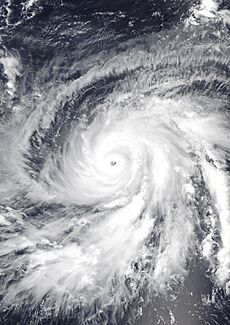
The Central Pacific Hurricane Center names storms in this area. They use four lists of Hawaiian names. These lists rotate without regard to the year. The names of important storms are retired and replaced.
Western Pacific Ocean Storms (180° – 100°E)
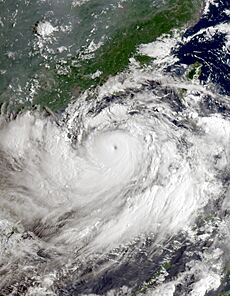
In the Northern Hemisphere, storms in the Western Pacific are officially named by the Japan Meteorological Agency when they become tropical storms. However, the Philippine Atmospheric, Geophysical and Astronomical Services Administration (PAGASA) also names storms that form or enter their area of responsibility. This means storms in this region can sometimes have two names.
International Names
The Japan Meteorological Agency assigns international names when storms have 10-minute sustained winds of at least 34 knots (63 km/h or 39 mph). These names come from five lists created by the Typhoon Committee, with each of 14 member countries submitting 10 names. Names are used in order and can be retired if a storm causes a lot of damage.
Philippines
Since 1963, PAGASA has used its own naming system for storms in its area. Names come from four lists of 25 names. They are assigned when a storm enters or forms as a tropical depression in PAGASA's area. These lists rotate every four years. Names of significant storms are retired if they cause major damage or deaths in the Philippines. If a list runs out of names, an auxiliary list is used.
North Indian Ocean Storms (100°E – 45°E)
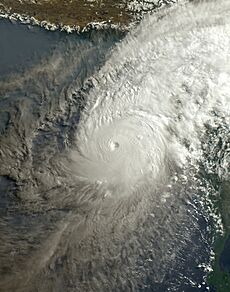
In the North Indian Ocean, storms are named by the India Meteorological Department. They get a name when they become "cyclonic storms" with 3-minute sustained winds of at least 34 knots (63 km/h or 39 mph). If a storm moves into this area from the Western Pacific, it keeps its original name. But if it weakens and then gets stronger again after moving in, it gets a new name.
South-West Indian Ocean Storms (west of 90°E)
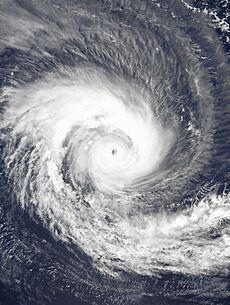
In the South-West Indian Ocean, storms are named when they become tropical storms with winds of at least 34 knots (63 km/h or 39 mph). This means strong winds are seen or expected near the storm's center. Storms are named by Météo Madagascar or the Mauritius Meteorological Service, working with Météo-France Reunion. The names come from three lists that rotate every three years. Used names are removed and replaced by new ones from member nations.
Australian Region Storms (90°E – 160°E)
In the Australian region, a tropical cyclone is named when observations show it has gale-force winds near its center that are expected to continue. The Indonesian Agency for Meteorology, Climatology, and Geophysics (BMKG) names storms between the Equator and 10°S, and 90°E and 141°E. Papua New Guinea's National Weather Service names storms between the Equator and 10°S, and 141°E and 160°E. Outside these areas, the Australian Bureau of Meteorology names storms. These centers can name a storm early if it's likely to become a named cyclone, to help communities prepare. If a named storm causes deaths or significant damage, its name is retired and replaced.
Indonesia
The BMKG names storms in its area using names from List A. List B has names that replace retired names from List A.
Papua New Guinea
The Papua New Guinea National Weather Service names storms in its area. Names are taken from List A and are automatically retired after being used, regardless of damage. List B contains replacement names.
Australia
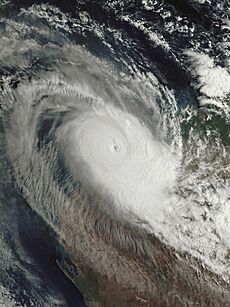
The Australian Bureau of Meteorology names storms that develop south of 10°S between 90°E and 160°E. Names are assigned in alphabetical order from rotating lists, without regard to the year.
Southern Pacific Ocean Storms (160°E – 120°W)
In the Southern Pacific, a tropical cyclone is named when it has gale-force winds near its center that are expected to continue. The Fiji Meteorological Service (FMS) names storms between the Equator and 25°S. The New Zealand MetService names storms south of 25°S, working with the FMS. The FMS can name a storm early if it's likely to become a named cyclone, to help local communities prepare. If a storm causes deaths or significant damage, its name is retired and replaced. Names are used from Lists A-D in order, then restart with List A. List E has standby names for replacements.
South Atlantic Ocean Storms
When a tropical or subtropical storm forms in the South Atlantic Ocean, the Brazilian Navy Hydrographic Center's Marine Meteorological Service names it. Names are chosen from a predetermined list in alphabetical order and rotate without regard to the year.
See also
 In Spanish: Nombres de los ciclones tropicales para niños
In Spanish: Nombres de los ciclones tropicales para niños
- Tropical cyclone scales
- Atlantic hurricane season
- South Atlantic tropical cyclone
- Pacific hurricane season
- Pacific typhoon season
- South Pacific tropical cyclone
- North Indian Ocean tropical cyclone
- South-West Indian Ocean tropical cyclone
- Australian region tropical cyclone
- Regional Specialized Meteorological Center
- Weather system naming in Europe


